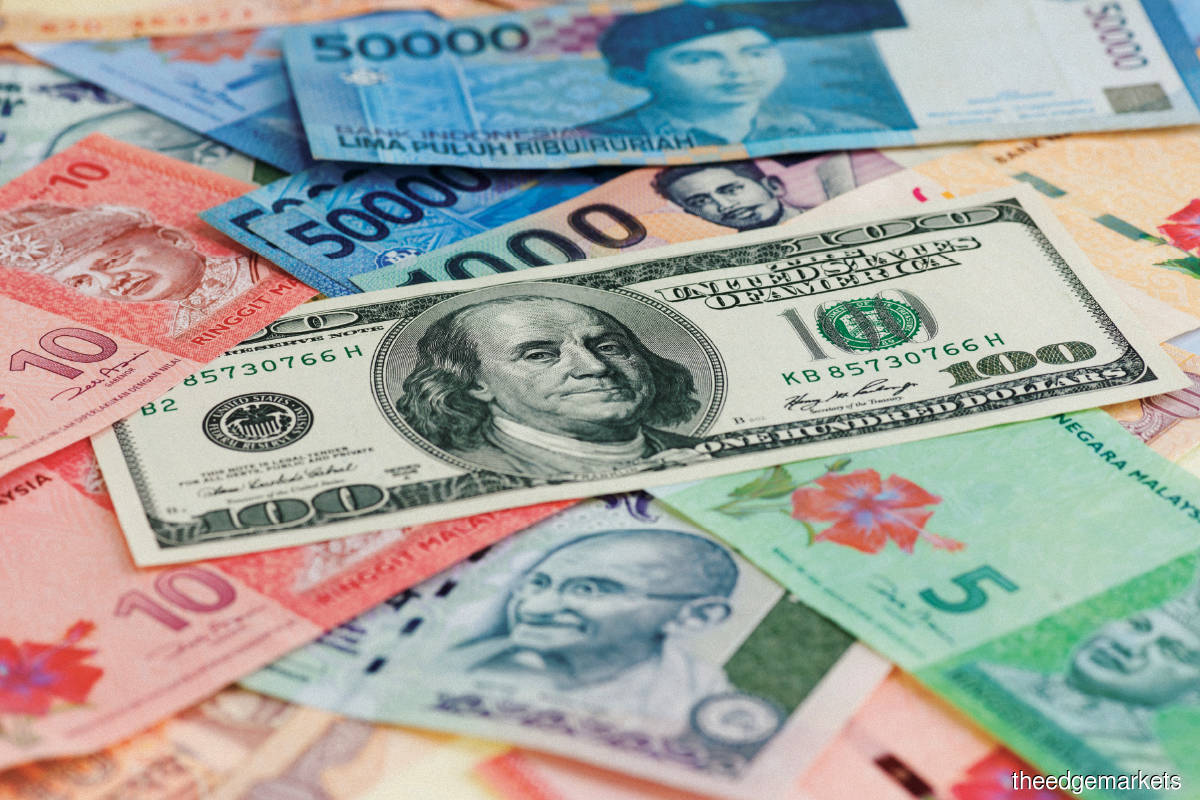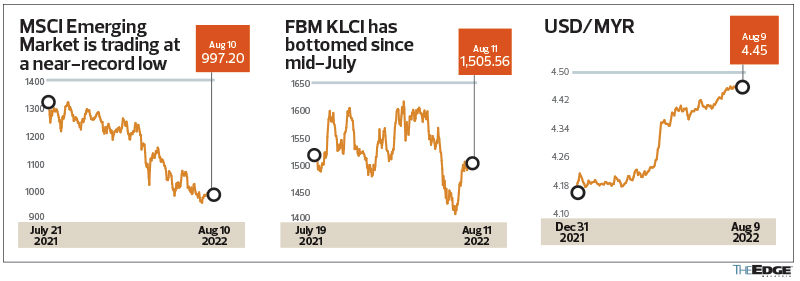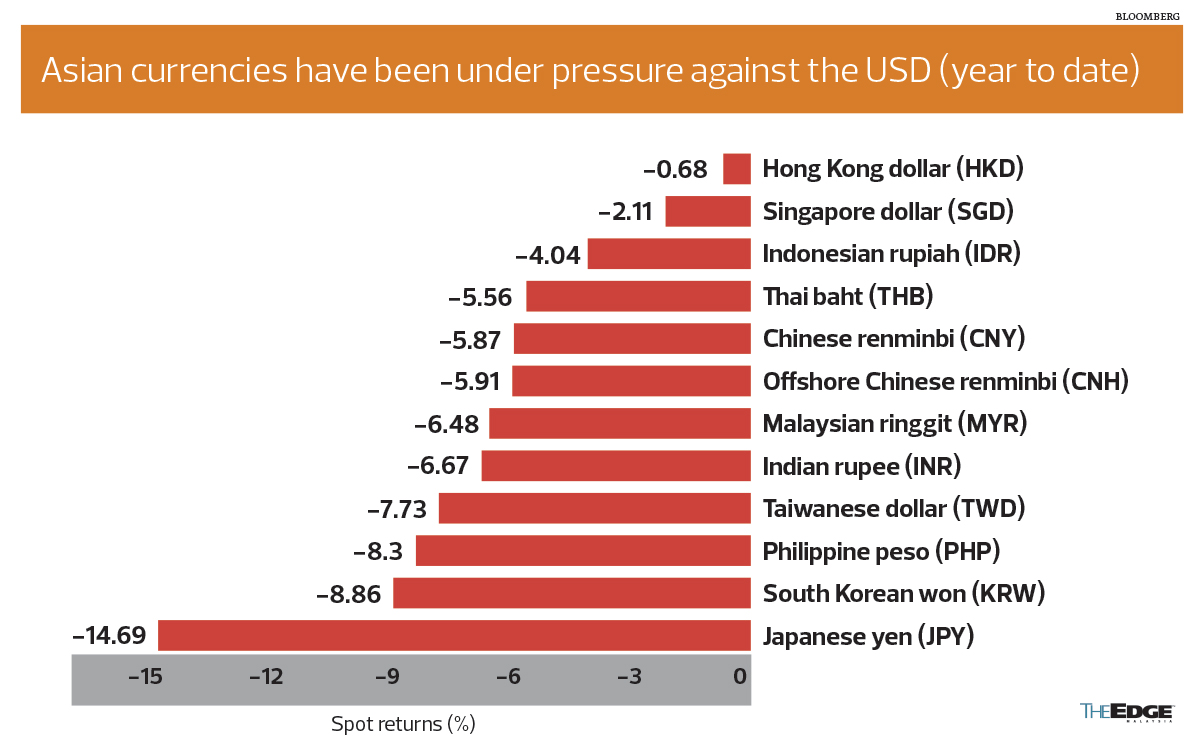Industries pressured by rate hikes and softer ringgit, but there are exceptions

SINCE last year, emerging market assets and Asian currencies have come under pressure from a stronger US dollar.
Emerging markets have been further spooked by more aggressive monetary policy by the US Federal Reserve since March, coupled with recent weakness in commodity prices and concerns over China’s growth, given its strict Covid-19 lockdowns.
Having raised its key rate by more than 225 basis points this year, the Fed is expected to continue with further increases of 50bps in September and another 25bps in November. By year-end, US interest rates could hit 3.25% to 3.50%.
Closer to home, Bank Negara Malaysia has raised its overnight policy rate (OPR) by 50bps this year to 2.25%, and market observers have pencilled in another 50bps hike before year-end.
UOB Group Research projected that foreign capital flows would likely remain volatile in the first half of 2022 to 2023 as investors weigh global recession risk, geopolitics and inflation against the Fed’s aggressive monetary tightening.
“Tighter global financial conditions, negative real interest rates and a stronger US dollar will continue to drive flow dynamics and investors’ risk appetite for emerging market assets,” it said in a report last Wednesday.
“In focus are China’s economic outlook and renewed geopolitical tensions with the US that could further weigh on Asian foreign exchange, including the Malaysian ringgit, in the near term.”
In July, UOB pointed out that foreign funds remained net sellers of Malaysian debt securities as Malaysia recorded foreign outflows of RM3.4 billion against RM5.4 billion in June.
On the equity market, the selling pressure could continue, especially as the Fed has yet to end its rate hikes.
Year to date, the FBM KLCI has dropped almost 4.3% while the MSCI Emerging Market Index has declined 19%. The latter is now trading at a near-record low, which could be inviting for investors to take another look emerging markets such as Malaysia’s.
But what of the shrinking ringgit?
Analysts observe that the weakness in the local currency is not entirely bad for companies in certain sectors.
Areca Capital Sdn Bhd CEO Danny Wong reckons that the manufacturing sectors, including the electrical and electronics (E&E), furniture and rubber glove industries, could stand to benefit from the stronger US dollar.
“While they stand to benefit from the weak ringgit, a rise in raw material costs could hurt, especially if the imported goods and services in their production mitigate the foreign exchange gains,” he tells The Edge when contacted.
This year alone, the ringgit has weakened 6.8% to RM4.46 against the US dollar — its weakest in five years. The local currency has also depreciated 4.6% to RM3.23 against the Singapore dollar.
Nonetheless, the ringgit still fared well against other regional currencies, such as the Philippine peso, Indian rupee and South Korean won. On a year-to-date basis, the ringgit has performed better against some of the other major currencies, appreciating against the euro (3%), sterling pound (3.6%) and Japanese yen (7.3%).
Overall, Wong says, there are signs that the selling pressure in the market has eased as the US dollar stabilised. “If the ringgit continues to weaken further, corporate earnings could be affected,” he adds.
In addition to that, Wong points out that the financial sector and cash rich companies can be positively impacted by rising interest rates.
He expects Bank Negara to set another two or three rate hikes over the next six months, in line with the decision of other regional central banks and the Fed.
“Bank Negara will try to catch up with the move by the Fed to raise interest rates. In addition, the inflationary pressures, especially for food items, are slowly creeping up, which will prompt the central bank to increase interest rates again in the second half of this year,” he says.
Echoing a similar view, analysts are mainly bullish on the banking sector. According to Bloomberg, 12 analysts have a “buy” call on the country’s largest bank by assets, Malayan Banking Bhd; 13 recommend a “buy” on CIMB Group Holdings Bhd; and 14 have “buy” calls for RHB Bank Bhd.
MIDF Research head Imran Yassin Md Yusof says the weak ringgit will make Malaysia’s exports more competitive. A report by MIDF points out that local semiconductor players such as Inari Amertron Bhd, Globetronics Technology Bhd and Unisem (M) Bhd generated their revenue in US dollars and could see changes in profitability from foreign exchange movement.
“Although the translation gains may be moderated by rising costs, demand may also increase, causing a positive net effect on exporters,” he tells The Edge.
“Sectors that will likely benefit from a stronger US dollar are the ones that generate their revenue in US dollars such as the technology sector, where we expect better earnings due to the currency translation gains and demand growth.
“For Inari, a 1% strengthening of the ringgit against the US dollar for FY2021 would decrease the group’s net profit for the financial year by RM3.82 million, ceteris paribus.
“Hence, the appreciation of the ringgit will have a negative impact on the players’ bottom line,” MIDF says.
Imran says companies in the consumer sector that export their products, such as Fraser & Neave Holdings Bhd, stand to benefit from the stronger greenback as most of their export sales are denominated in US dollars, which could more than offset the higher raw material costs.
Conversely, those in the consumer sector that import their raw materials and sell their products in Malaysia, such as Nestle (Malaysia) Bhd, could see their bottom line affected by the stronger US dollar.
The group’s profit after tax is estimated to increase 1.3% for every 5% decrease in US dollar.
“However, the exposure is mostly hedged through forward exchange contracts and export sales against the varying commodity prices and foreign exchange movement,” Imran says.
“Another is the automotive sector, which is mainly exposed to US dollars for imported components. The power sector is also exposed to forex fluctuations, given that coal is purchased in US dollars,” he adds.
Pressure from strong US dollar could be easing
There seems to be no respite for the ringgit, which over the past four months has lost 6.8% against the US dollar year to date.
Since last week, the local unit has traded at around 4.46 to the dollar, flirting with levels not seen since the depths of the Asian financial crisis more than 18 years ago.
However, some market observers point out that the US dollar is unlikely to strengthen further and is “overvalued” currently.
CIMB Group co-CEO of wholesale banking Chu Kok Wei says the ringgit could end the year at RM4.35, and that it is unlikely to touch the psychological level of RM4.50.
“I do not foresee this in the near term unless there are significant global events such as a dramatic worsening of the Russia-Ukraine situation or escalation of China-US tensions over Taiwan that will cause safe-haven flows into the US dollar.
“These scenarios are underpinned by US dollar strength against global emerging market currencies, instead of specific ringgit weakness,” he adds.
He points out that the Fed rate hikes were already highly anticipated by the market, and that Bank Negara has taken the necessary steps to increase the OPR rate.
“Expected movement in interest rates should have been priced in, hence I do not expect increasing future outflows unless there is renewed anticipation of further unexpected hikes by the Fed beyond the current expectations,” he adds.
Meanwhile, Maybank Group regional head of FX research and strategy Saktiandi Supaat expects the ringgit to breach the RM4.50 level against the greenback if the US dollar strengthens further.
“There are risks of the US dollar strengthening if inflation numbers rise ahead and, in turn, creating the expectation that the Fed’s rate hikes may be aggressive in September.
“Although the Fed chairman recently signalled that rate hikes may not be aggressive moving forward, San Francisco Fed president Mary Daly told Reuters recently that should inflation figures come in stronger, the Fed may increase rate hikes by 75bps,” he says.
In the short-term horizon, Saktiandi foresees the ringgit-US dollar pair trading in the RM4.40-to-RM4.50 range as concerns over global recession and domestic politics create volatility in the ringgit.
“In summary, the weakness was largely driven by exogenous factors, including the earlier rise in US Treasuries yields, US dollar strength, sharp and continued decline in offshore RMB (of which the ringgit has a strong correlation to), International Monetary Fund’s downgraded global growth, risks of a China slowdown amid extended lockdowns and the ongoing war in Ukraine.
“Some of these drivers have eased but lingering concerns about global growth and risk aversion will continue to support the US dollar and raise cautious views of risky assets for the next few months, which may keep the ringgit range-bound around 4.40 to 4.45,” he explains.
For an open economy like Malaysia’s, currency movement is an important component that contributes to the performance of the local companies. The local stock market, along with other emerging markets, is showing signs of bottoming out as the US dollar appreciation eases. That said, the weakness in the local currencies will eat into companies’ returns.
The content is a snapshot from Publisher. Refer to the original content for accurate info. Contact us for any changes.
Related Stocks
| CIMB | 6.680 |
| F&N | 31.560 |
| FBMKLCI | 1569.250 |
| GTRONIC | 1.240 |
| INARI | 3.060 |
| MAYBANK | 9.780 |
| NESTLE | 127.000 |
| RHBBANK | 5.510 |
| UNISEM | 3.640 |
Comments

